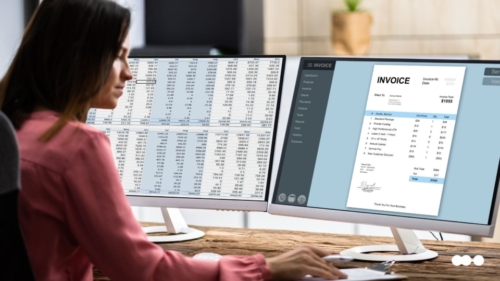
The accounts receivable process (or AR process) is one of the most important financial functions in a company because it shows how efficiently a company processes incoming cash flow — an excellent indicator of a company’s financial health. However, while cash flow is important, there are other factors to take into account like speed, accuracy, and reliability.
Depending on the size of a company, this is something easier said than done – especially when it comes to managing a high volume of documents, like purchase orders and invoices, and AR steps, like recording payments and invoice reconciliation.
Without proper documentation, procedures, and process improvements, the AR process can become cluttered and create problems that not only affect your finances, but it can also negatively impact your company’s reputation and trustworthiness.
Definitive Guide to Workflow ManagementDownload now
Common process challenges and their impact
Manually processing information stands as one of the most common problems for accounts receivable processes. From this one challenge, many other issues occur that can affect a company’s finances and reliability. When combined, whether at a large or small scale, the end result is an inefficient, inaccurate, and time-consuming accounts receivable process. Here’s a breakdown of some of those challenges:
| Challenge | What that looks like |
|---|---|
| Data entry errors | Double billing, incorrect balances, delayed payment entry, poor customer experience, lots of time wasted fixing mistakes |
| Lack of process visibility | Dependence on paperwork and spreadsheets, inability to scale, version control and accessibility issues, missing information, misplaced documents |
| Inconsistent, fragmented workflows | Difficult to enforce security and compliance measures, lack of collaboration, difficulty viewing statuses |
How to improve accounts receivable processes with automation
Businesses can only operate with reliable income, and that income depends on the efficient processing of customer payments. Business process automation takes the guesswork out of process management and empowers teams to create process workflows that eliminate extra work and improve process efficiency.
A well-run accounts receivable department that’s accurate, efficient, and frictionless is essential to maintaining overall financial health. Here are five ways automation can improve your existing accounts receivable process.
1. Eliminate repetitive tasks and make more time for customers
Much of the key work that goes into running an accounts receivable process is usually routine and mechanical, such as:
- Updating customer accounts
- Submitting invoices for approval
- Recording payments as received
- Sending payment reminders
By automating these repetitive tasks, teams can make time for more complex tasks, have more time with customers, and can deliver better customer experiences.
| 6 days | $16-$22 |
|---|---|
| Average time spent manually processing a physical invoice | Cost of manually processing individual invoices |
2. Optimize the credit approval workflow
It’s not uncommon for suppliers to offer buyers credits, discounts, or even extended payment dates, especially if they’ve proven to be trustworthy. However, this can easily result in a customer base that routinely pays late, putting the company’s balance sheet in jeopardy.
By establishing a formal credit approval subprocess within the AR process, the risks and time spent managing late payments are reduced. Here are some tips for gettings started:
- Work with sales and finance teams so that the rules will be reasonable and based on transaction size.
- Create a standardized checklist for new customers that includes a credit report analysis and background checks for large accounts.
- Set as many procedures as you need for different buyer levels, and review them regularly to make sure they’re appropriate and competitive.
- Establish accountability and set a time limit on approving or rejecting credit applications. If you’ve told sales that you’ll turn around credit requests in X number of days, they’ll quote that number to their customers.
Build on this step by leveraging automation. Set up automatic notifications as payment deadlines approach and send automated reminders when approvals are due, so clerks can follow up in person or by phone if necessary.
| $3 trillion | 43% |
|---|---|
| Total amount U.S. companies are owed in outstanding accounts receivable | Amount of overdue B2B invoices in the U.S. |
3. Centralize customer data for an error-proof process
One of the most common challenges finance teams face is dealing with a complex set of apps, spreadsheets, and databases. This leads to data silos and creates additional work because data has to be manually moved from one app to the next.
Inaccurate customer accounts lead to invoice errors, lost bills, and more late payments, so a profitable accounts receivable process is only possible if your customer records are accurate and up-to-date. To begin this improvement, pay particular attention to trends of inaccuracy. If you have one product line that has a higher rate of duplicate records or non-approved payment arrangements, track the inconsistency to its source. Find out how you can improve record-keeping to reduce the rate of error.
After auditing your customer data, leveraging a low-code solution that includes features like database integrations and dashboards that report real-time analytics can minimize, and even eliminate, issues like:
- Duplicate records
- Records with the same name but different addresses
- Outdated payment agreements
- Atypical credit limits or payment arrangements
- Unexplained discounts
Automation can help you here too. A BPA tool that can integrate with your existing tech stack creates a better user experience for customers and employees.
It also automates the process of moving data to reduce errors and save time. A database that automatically updates a record when information changes stops duplicated and outdated information, so teams have access to the most up-to-date information.
| 10% to 20% |
|---|
| Average among of customer files that go out of date in a given year |
4. Standardize the collection of overdue invoices
Late payments are costly. In addition to costing companies money, late payments also make it difficult for companies to pay their own employees and vendors. This can result in even bigger issues like layoffs or, worse, the end of their business.
So while you can’t stop customers from paying late, you can become more proactive about collecting. Establish a timeline for following up, starting with the first call or email after the invoice has passed its due date.
Again, automation is particularly helpful with this task, especially automated email templates. Here’s how:
| Day of an invoice due date After one to two days after invoice due date | After one to two days after invoice due date | After three to five days after invoice due date |
|---|---|---|
| Draft an email template that will automatically be shared with the customer the day payment is due. Based on your operating hours, make the automated more specific and set the email to be shared at or after a specific hour. | Draw up email templates to go out at regular intervals, starting no more than a day or two after the invoice’s due date. In each one, remind the customer of the amount due, including any late fees, and remind them of any additional fees that may be upcoming. | If payment is still due, have a contingency plan in place. Draw up another email template to go out after what is a reasonable amount of time for your business, gently reminding them that default may lead to legal action. |
By automating manual follow-ups and standardizing this practice for all customers, teams can say goodbye to “forgotten” accounts. After all, an automated system won’t forget to email a delinquent client.
5. Improve the cash application process
While it’s important to focus on reducing your late-payment rates, don’t lose sight of the payments that do come in on time.
Cash application is easily overlooked within the accounts receivable process flow, mostly because it seems at first glance to be simple — payments come in, they are applied to accounts, and they get recorded as paid.
But if something goes wrong during the cash application, it may cost you time and money to fix the issues. This is why it’s safer to keep up with late payments and formalize a cash application process to ensure teams aren’t spending time doing time-consuming rework. Here’s how:
- First, establish the expectation that payments will be applied to the appropriate account and invoice on the day they come in. Deloitte recommends making this the norm so that you always know which accounts are pending, due, or late.
- Next, set up a schedule for reconciling accounts. This can happen monthly, bimonthly, or less often — it all depends on your staff and how many invoices you take in regularly. Be clear about who is involved in this process.
- Then, establish a procedure for resolving unidentified receipts and invoices so that they don’t linger.
- Finally, automate this procedure to standardize and streamline account reconciliation. If you have notifications that go out when it’s time to review a payment or reconcile an account or when the reconciliation process is considered late, these steps will become a habit faster.
Bottom line: Why automation is good for accounts receivable
Business process automation lets teams do more, and makes business processes more efficient and error-proof – two critical requirements needed for a profitable accounts receivable department.
Leveraging a low-code automation tool helps teams:
- Save time by automating repetitive work so teams can focus on high-level work.
- Save money by standardizing process procedures to ensure an error-proof operation.
- Communicate better — internally and externally — with automatic notifications, emails, review assignments, and data centralization so that stakeholders have full process visibility.
- Gain visibility over the accounts receivable process with real-time analytics and process audit tracking.
- Be more agile and respond to real-time needs like updating workflows or adding new procedures to the accounts receivable process for end-to-end efficiency.










